
HybridAGI
The Programmable Cypher-based Neuro-Symbolic AGI that lets you program its behavior using Graph-based Prompt Programming: for people who want AI to behave as expected
Stars: 597
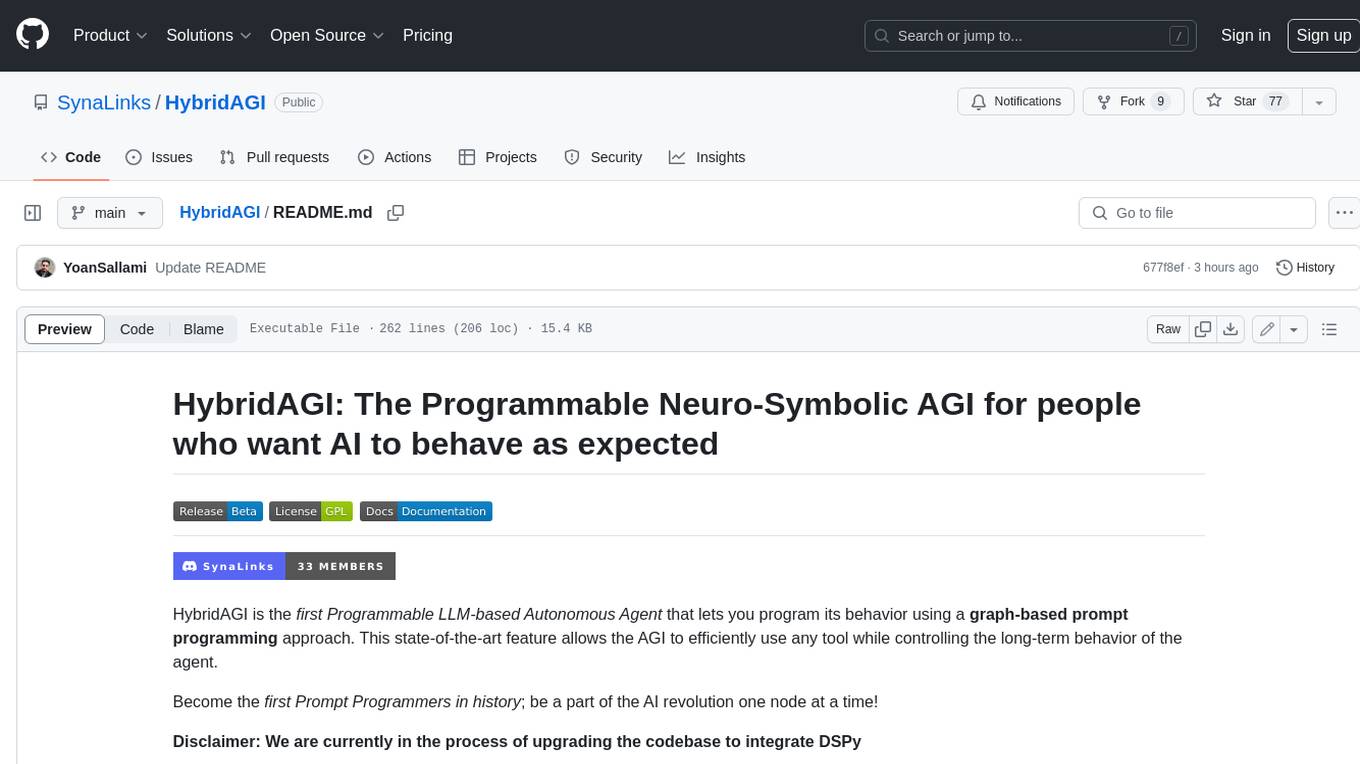
HybridAGI is the first Programmable LLM-based Autonomous Agent that lets you program its behavior using a **graph-based prompt programming** approach. This state-of-the-art feature allows the AGI to efficiently use any tool while controlling the long-term behavior of the agent. Become the _first Prompt Programmers in history_ ; be a part of the AI revolution one node at a time! **Disclaimer: We are currently in the process of upgrading the codebase to integrate DSPy**
README:
Disclaimer: We are currently refactoring the project for better modularity and better ease of use. For now, only the Local integration if available, the FalkorDB & Kuzu integration will be done at the end of this refactoring. At that time we will accept contributions for the integration of other Cypher-based graph databases. For more information, join the Discord channel.
-
Turing Complete DSL: HybridAGI's Turing Complete Domain Specific Language (DSL) has been specifically designed to describe an infinite number of algorithms using only 4 different types of nodes (Control, Action, Decision, Program). The interpreter Agent can loop and call subprograms, similar to a traditional programming language.
-
Graph Program Search & Dynamic Call: Because our agent system is not a static finite state machine but an interpreter that interprets a graph-based DSL node by node, it can search programs into memory and dynamically call the best one to solve the user query.
-
Optimizable Pipeline & Agent: With HybridAGI and DSPy, you can optimize the data processing pipelines and the agent system to your own needs. Since each HybridAGI module is also a DSPy module, you can use DSPy optimizers seamlessly with them.
-
Agent Behavior as Software: With HybridAGI, you can ship the Agent's behavior as Cypher software, enabling start-ups and companies to create their own IP based on their business logic implemented in Cypher.
-
Memory-Centric System: HybridAGI is a memory-centric system that heavily uses Knowledge Graphs, both for executing programs and to store structured knowledge. This enables Knowledge Graph RAG applications for critical domains.
-
Secure and Safe: Special attention has been given to prevent Cypher Injections but also to prevent the Agent system from modifying its own main prompting mechanism by introducing the concept of protected programs.
- Datatypes
- GraphPrograms
- Interpreter Prompting
- Simulating User
- Vector Only RAG
- Knowledge Graph RAG
- Episodic RAG
- Extracting Knowledge Graphs
- Dynamic Graph Program
- Using External Tools
- Add Documents (on the fly)
- Add Facts (on the fly)
- ReACT Agent
HybridAGI is the first programmable LLM-based Agent that enables you to define its behavior using a graph-based prompt programming approach. Unlike other frameworks that view agents as advanced chatbots, we have adopted a methodology that is rooted in computer science, cognitive sciences, and symbolic AI.
To us, an agent system is an goal-directed cognitive software that can process natural language and execute the tasks it has been programmed to perform. Just like with traditional software, the developer specifies the behavior of the application, and the system is not truly autonomous unless it has been programmed to be so. Programming the system not only helps the agent to carry out its tasks but also allows for the formalization of the developer's intent.
HybridAGI is designed for data scientists, prompt engineers, researchers, and AI enthusiasts who love to experiment with AI. It is a "Build Yourself" product that focuses on human creativity rather than AI autonomy.
We are not satisfied with the current trajectory of Agent-based systems that lack control and efficiency. Today's approach is to build React/MKRL agents that do what they want without any human control, resulting in infinite loops of nonsense because they tend to stay in their data distribution. Multi-agent systems try to solve that, but instead result in more nonsense and prohibitive costs due to the agents chitchatting with each other. Moreover, today's agents require fine-tuning to enhance/correct the behavior of the agent system. In contrast, with HybridAGI, the only thing you need to do is to modify the behavior graph (the graph programs).
We advocate that fine-tuning should be done only as a last resort when in-context learning fails to give you the expected result. Any person who has already fine-tuned a LLM knows that gathering data is hard, but having the right variability in your dataset is even harder, thus prohibiting most companies from leveraging this technology if they don't have many AI scientists. By rooting cognitive sciences into computer science concepts, without obfuscating them, we empower programmers to build the Agent system of their dreams by controlling the sequence of action and decision.
Our goal is to build an agent system that solves real-world problems by using an intermediary language interpretable by both humans and machines. If we want to keep humans in the loop in the coming years, we need to design Agent systems for that purpose.
pip install hybridagi
No React Agents here, the only agent system that we provide is our custom Graph Interpreter Agent that follow a strict methodology by executing node by node the graph programs it have in memory. Because we control the behavior of the Agent from end-to-end by offloading planning to symbolic components, we can correct/enhance the behavior of the system easely, removing the needs for finetuning but also allowing the system to learn on the fly.
HybridAGI is build upon years of experience in making reliable Robotics systems. We have combined our knowledge in Robotics, Symbolic AI, LLMs and Cognitive Sciences into a product for programmers, data-scientists and AI engineers. The long-term memory of our Agent system heavily use graphs to store structured and unstructured knowledge as well as its graph programs.
We provide everything for you to build your LLM application with a focus around Cypher Graph databases. We provide also a local database for rapid prototyping before scaling your application with one of our integration.
Because we don't let the Agent choose the sequence of tools to use, we can use an infinite number of tools. By following the Graph Programs, we ensure a predictable and deterministic methodology for our Agent system. We can combine every memory system into one unique Agent by using the corresponding tools without limitation.
With HybridAGI you can build data extraction pipelines, RAG applications or advanced Agent systems, each being possibly optimized by using DSPy optimizers. We also provide pre-made modules and metrics for easy prototyping.
Each module and data type is strictly typed and use Pydantic as data validation layer. You can build pipelines in no time by stacking Modules sequentially like in Keras or HuggingFace.
We provide the following list of native tools to R/W into the memory system or modify the state of the agent:
| Tool Name | Usage |
|---|---|
Predict |
Used to populate the context with reasoning information |
ChainOfThought |
Used to populate the context with reasoning information |
Speak |
Used to send message to the User and give the final answer |
AskUser |
Used to ask question to the User (can simulate the user persona) |
UpdateObjective |
Update the long-term Objective of the Agent |
AddDocument |
Save into memory a new document |
AddFacts |
Save into memory new facts |
DocumentSearch |
Used to search for information into the document memory |
PastActionSearch |
Used to search for past actions into the trace memory |
EntitySearch |
Used to search for entities into the fact memory |
FactSearch |
Used to search for facts into the fact memory |
QueryFacts |
Used to query facts from the fact memory |
GraphProgramSearch |
Used to search for graph programs into the program memory |
ReadGraphProgram |
Used to read a graph program from memory by name |
CallGraphProgram |
Used to dynamically call a graph program from memory by name |
You can add more tools by using the FunctionTool and python functions like nowadays function calling.
- Local Graph Memory for rapid prototyping based on NetworkX
- FalkorDB low latency in-memory hybrid vector/graph database (coming soon)
- Kuzu A highly scalable, extremely fast, easy-to-use embeddable graph database (coming soon)
What makes our approach different from Agent as Graph is the fact that our Agent system is not a process represented by a graph, but an interpreter that can read/write and execute a graph data (the graph programs) structure separated from that process. Making possible for the Agent to learn by executing, reading and modifying the graph programs (like any other data), in its essence HybridAGI is intended to be a self-programming system centered around the Cypher language. It is a production-ready research project centered around neuro-symbolic programming, program synthesis and symbolic AI.
We focus on explainable and robust systems, we don't support ReACT Agents that lack control and efficiency. The Agent system we provide, is custom made. We also provide everything to scale your application into production by offering optimizable pipelines, agents and graph databases integrations. Our system is a memory-centric agent with a special care to the long-term memory. Moreover our codebase is readable, clean and elegant we didn't over-engineer our system to obfuscate it to sell other services.
Unlike DSPy, our programs are not static but dynamic and can adapt to the user query by dynamically calling programs stored into memory. Moreover we focus our work on explainable neuro-symbolic AGI systems using Graphs. The graph programs are easier to build than implementing them from scratch using DSPy. If DSPy is the PyTorch of LLM applications, think of HybridAGI as the Keras or HuggingFace of neuro-symbolic LLM applications.
Become a part of our community of developers, researchers, and AI enthusiasts. Contribute to the project, share your feedback, and help shape the future of HybridAGI. We welcome and value your participation!
We're not based in Silicon Valley or part of a big company; we're a small, dedicated team from the south of France. Our focus is on delivering an AI product where the user maintains control. We're dissatisfied with the current trajectory of Agent-based products. We are expert in human-robot interactions and building interactive systems that behave as expected. While we draw inspiration from cognitive sciences and symbolic AI, we aim to keep our concepts grounded in computer science for a wider audience.
Our mission extends beyond AI safety and performance; it's about shaping the world we want to live in. Even if programming becomes obsolete in 5 or 10 years, replaced by some magical prompt, we believe that traditional prompts are insufficient for preserving jobs. They're too simplistic and fail to accurately convey intentions.
In contrast, programming each reasoning step demands expert knowledge in prompt engineering and programming. Surprisingly, it's enjoyable and not that difficult for programmers, you'll gain insight into how AI truly operates by controlling it, being able to enhance the sequence of action and decision. Natural language combined with algorithms opens up endless possibilities. We can't envision a world without it.
Our software is released under GNU GPL license to protect ourselves and the contributions of the community. The logic of your application being separated (the graph programs) there is no IP problems for you to use HybridAGI. Moreover when used in production, you surely want to make a FastAPI server to request your agent and separate the backend and frontend of your app (like a website), so the GPL license doesn't contaminate the other pieces of your software.
For Tasks:
Click tags to check more tools for each tasksFor Jobs:
Alternative AI tools for HybridAGI
Similar Open Source Tools

HybridAGI
HybridAGI is the first Programmable LLM-based Autonomous Agent that lets you program its behavior using a **graph-based prompt programming** approach. This state-of-the-art feature allows the AGI to efficiently use any tool while controlling the long-term behavior of the agent. Become the _first Prompt Programmers in history_ ; be a part of the AI revolution one node at a time! **Disclaimer: We are currently in the process of upgrading the codebase to integrate DSPy**
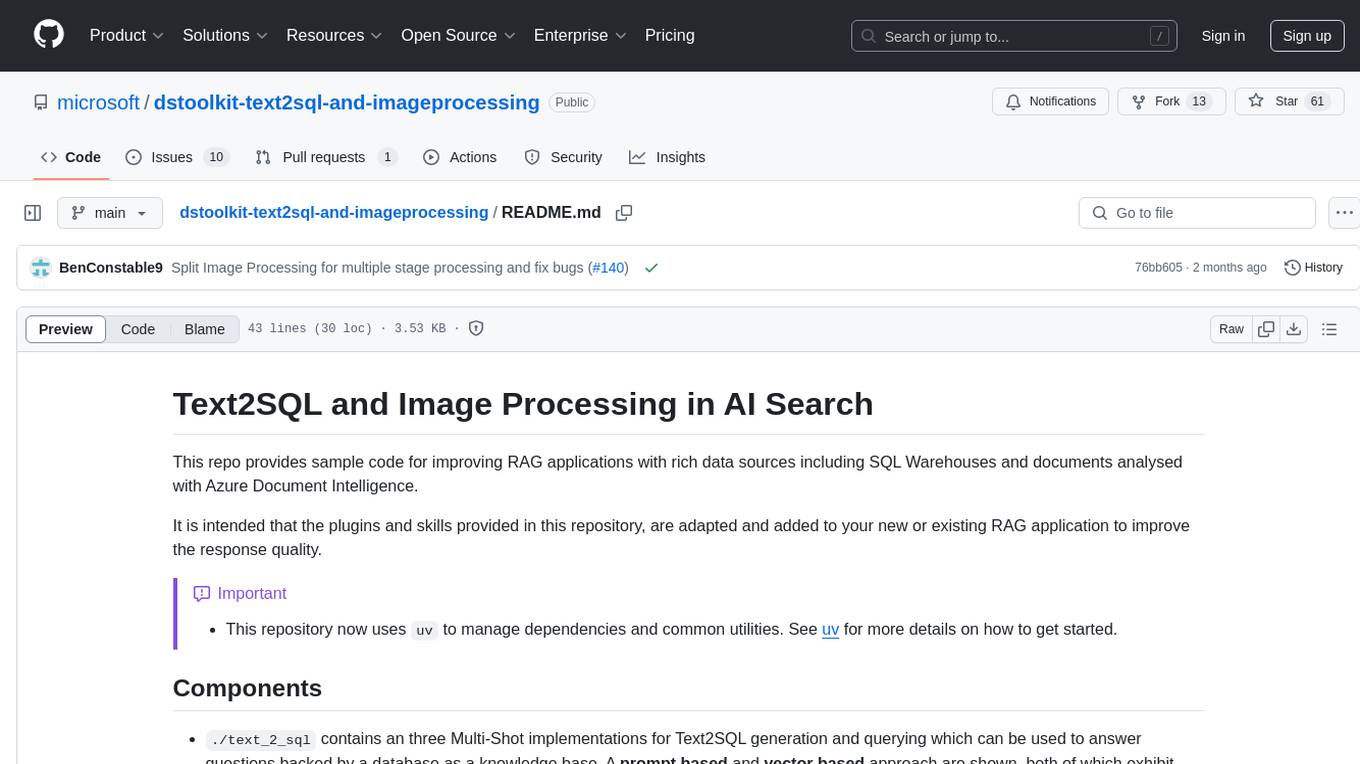
dstoolkit-text2sql-and-imageprocessing
This repository provides sample code for improving RAG applications with rich data sources including SQL Warehouses and documents analysed with Azure Document Intelligence. It includes components for Text2SQL generation and querying, linking Azure Document Intelligence with AI Search for processing complex documents, and deploying AI search indexes. The plugins and skills aim to enhance response quality in RAG applications by accessing and pulling data from SQL tables, drawing insights from complex charts and images, and intelligently grouping similar sentences.
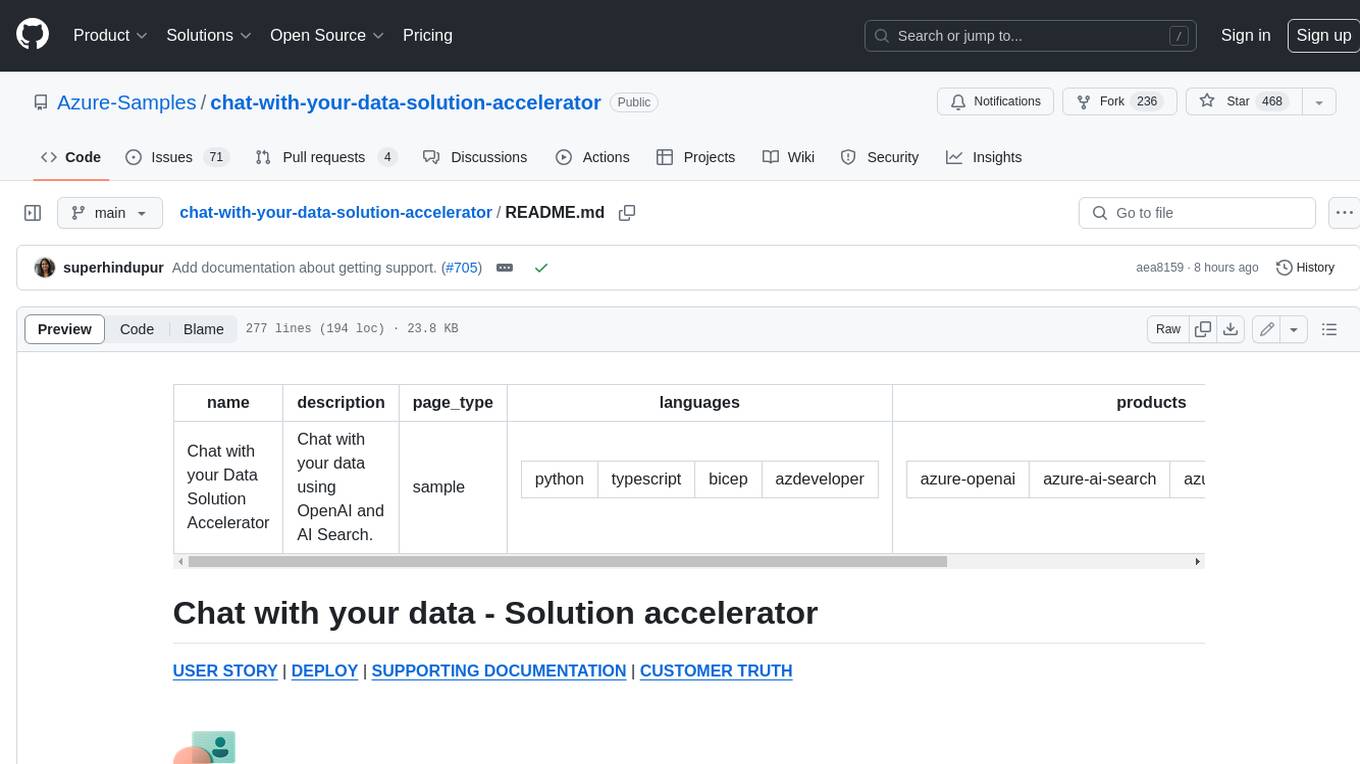
chat-with-your-data-solution-accelerator
Chat with your data using OpenAI and AI Search. This solution accelerator uses an Azure OpenAI GPT model and an Azure AI Search index generated from your data, which is integrated into a web application to provide a natural language interface, including speech-to-text functionality, for search queries. Users can drag and drop files, point to storage, and take care of technical setup to transform documents. There is a web app that users can create in their own subscription with security and authentication.
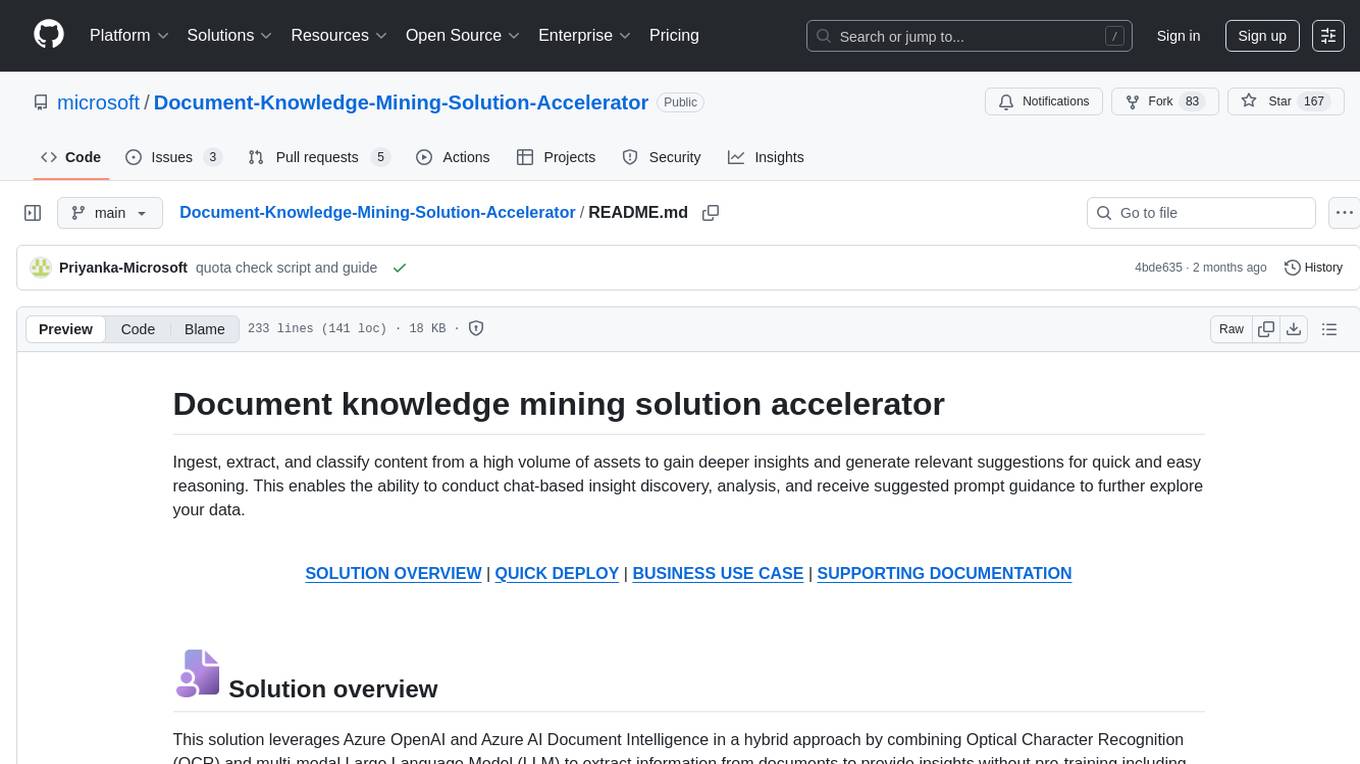
Document-Knowledge-Mining-Solution-Accelerator
The Document Knowledge Mining Solution Accelerator leverages Azure OpenAI and Azure AI Document Intelligence to ingest, extract, and classify content from various assets, enabling chat-based insight discovery, analysis, and prompt guidance. It uses OCR and multi-modal LLM to extract information from documents like text, handwritten text, charts, graphs, tables, and form fields. Users can customize the technical architecture and data processing workflow. Key features include ingesting and extracting real-world entities, chat-based insights discovery, text and document data analysis, prompt suggestion guidance, and multi-modal information processing.
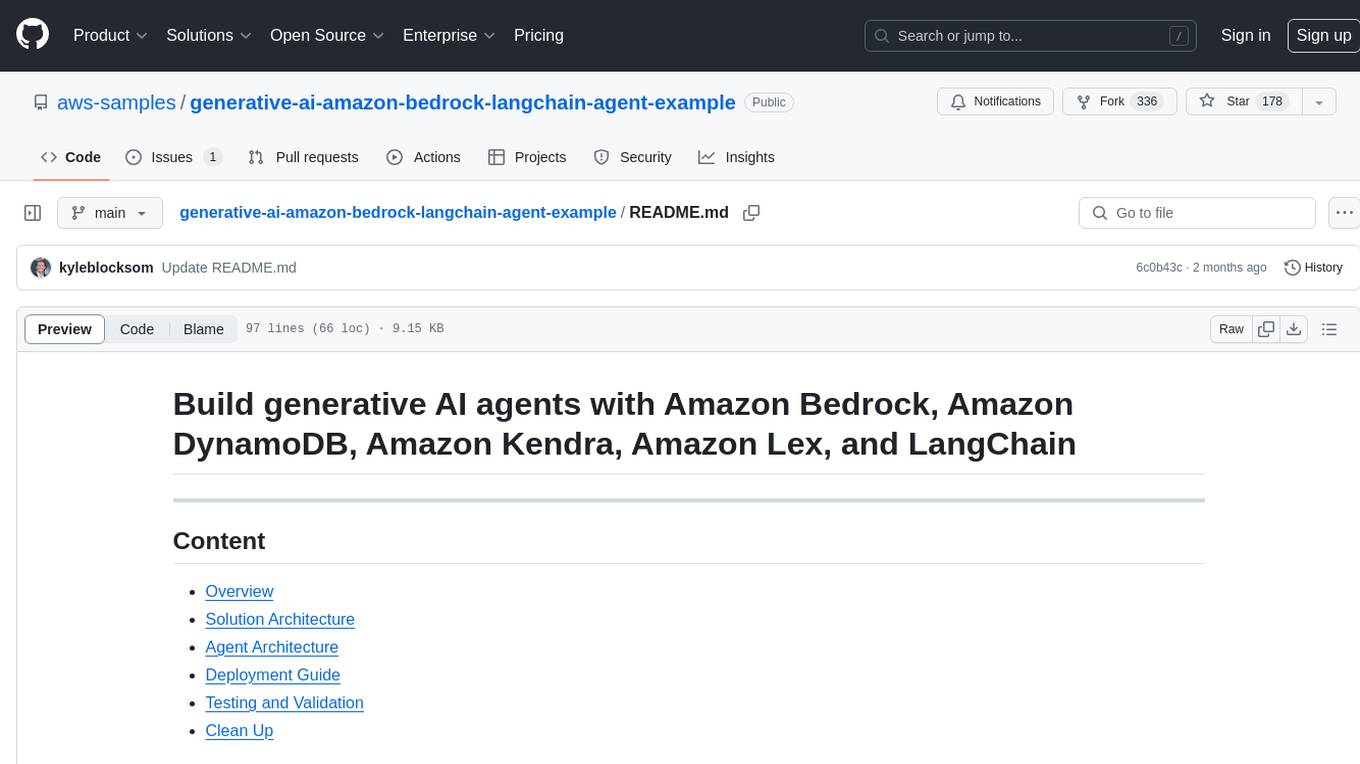
generative-ai-amazon-bedrock-langchain-agent-example
This repository provides a sample solution for building generative AI agents using Amazon Bedrock, Amazon DynamoDB, Amazon Kendra, Amazon Lex, and LangChain. The solution creates a generative AI financial services agent capable of assisting users with account information, loan applications, and answering natural language questions. It serves as a launchpad for developers to create personalized conversational agents for applications like chatbots and virtual assistants.
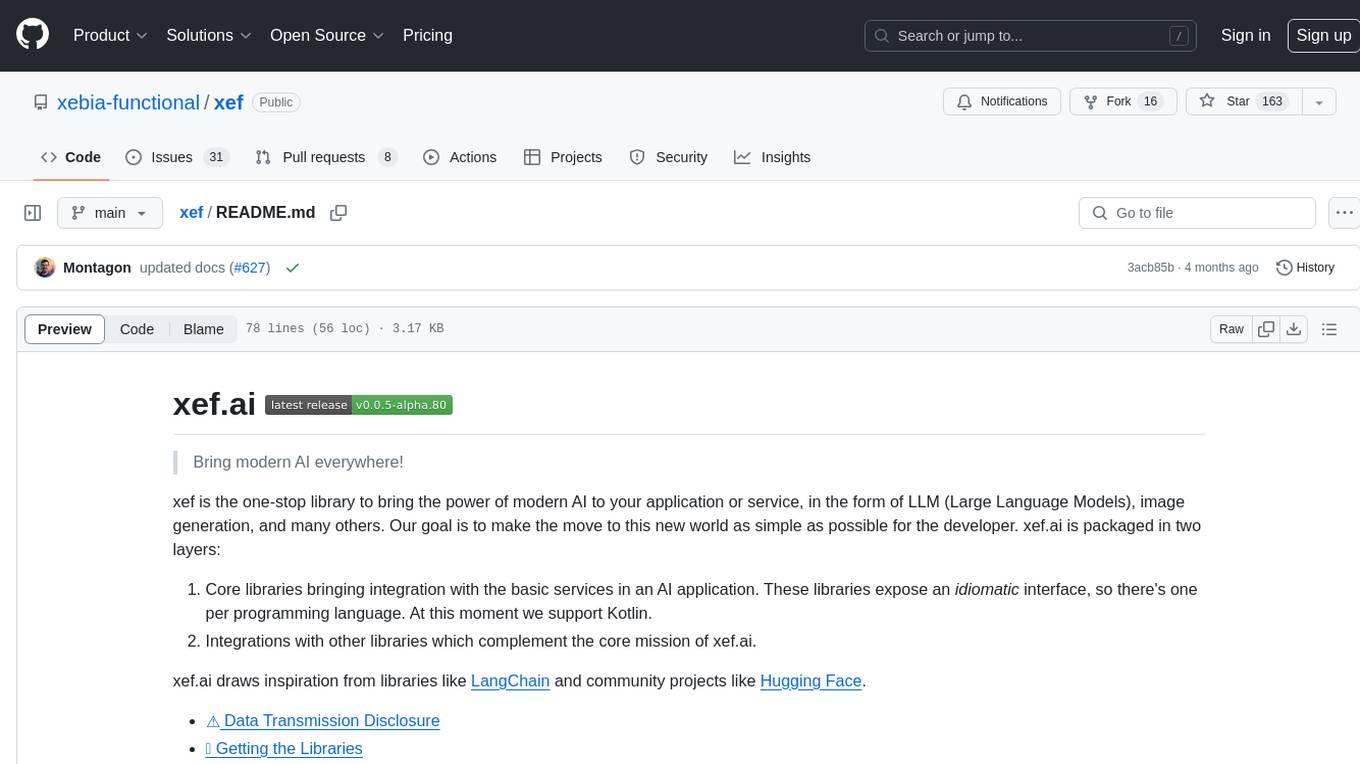
xef
xef.ai is a one-stop library designed to bring the power of modern AI to applications and services. It offers integration with Large Language Models (LLM), image generation, and other AI services. The library is packaged in two layers: core libraries for basic AI services integration and integrations with other libraries. xef.ai aims to simplify the transition to modern AI for developers by providing an idiomatic interface, currently supporting Kotlin. Inspired by LangChain and Hugging Face, xef.ai may transmit source code and user input data to third-party services, so users should review privacy policies and take precautions. Libraries are available in Maven Central under the `com.xebia` group, with `xef-core` as the core library. Developers can add these libraries to their projects and explore examples to understand usage.
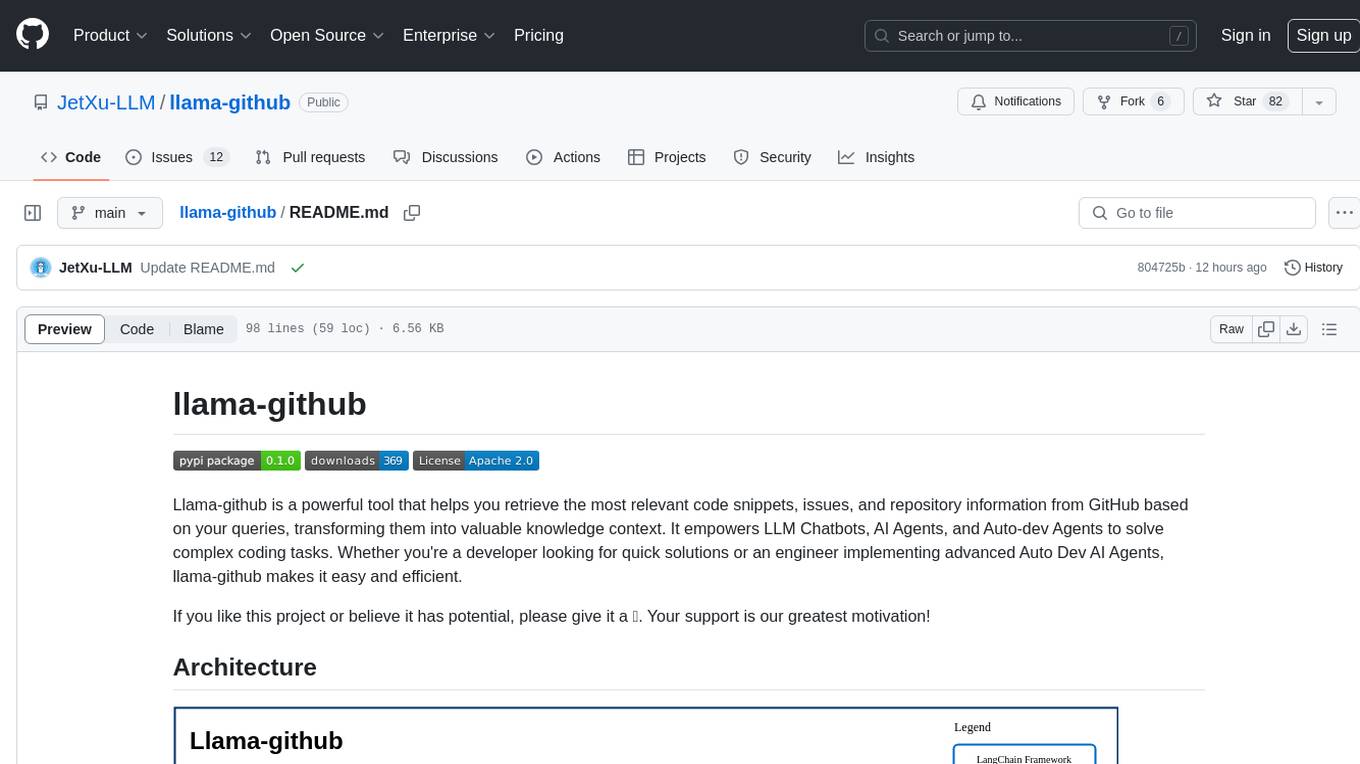
llama-github
Llama-github is a powerful tool that helps retrieve relevant code snippets, issues, and repository information from GitHub based on queries. It empowers AI agents and developers to solve coding tasks efficiently. With features like intelligent GitHub retrieval, repository pool caching, LLM-powered question analysis, and comprehensive context generation, llama-github excels at providing valuable knowledge context for development needs. It supports asynchronous processing, flexible LLM integration, robust authentication options, and logging/error handling for smooth operations and troubleshooting. The vision is to seamlessly integrate with GitHub for AI-driven development solutions, while the roadmap focuses on empowering LLMs to automatically resolve complex coding tasks.
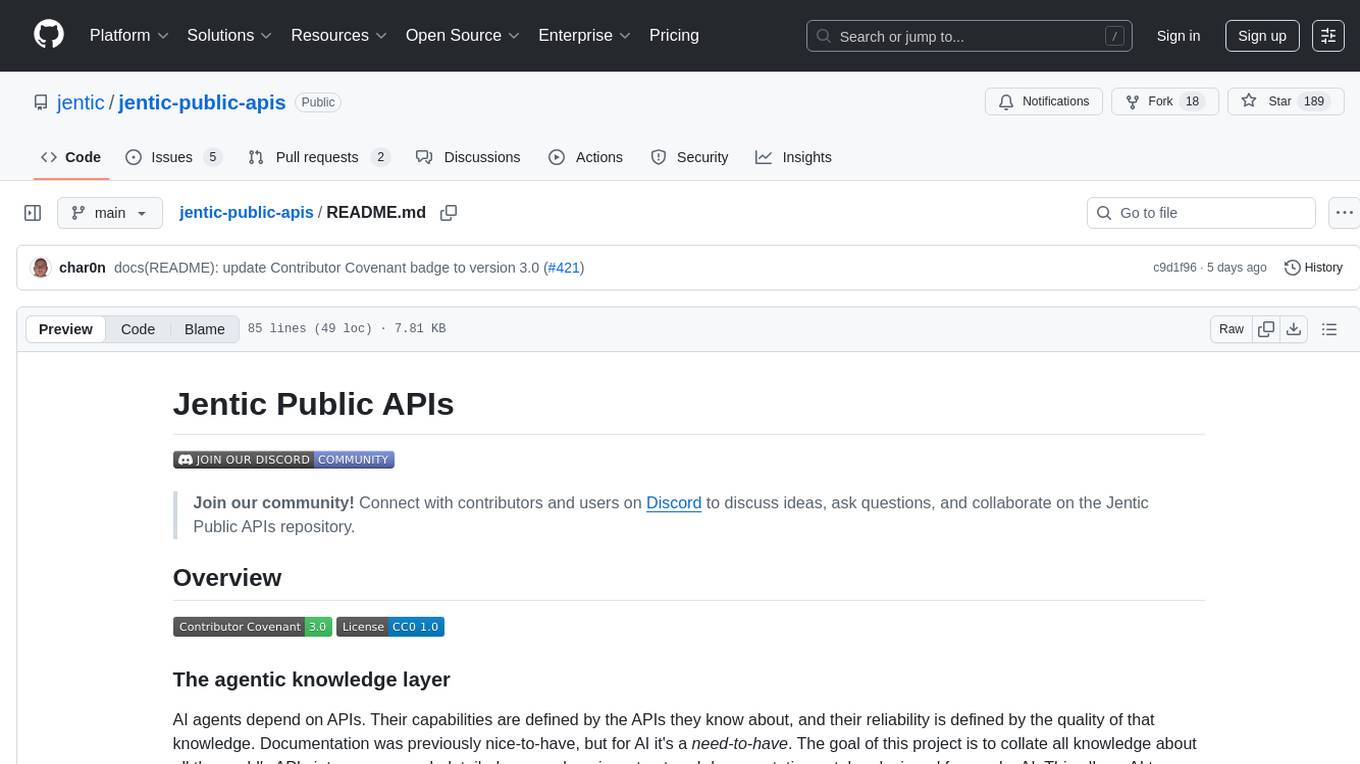
jentic-public-apis
The Jentic Public APIs repository aims to collate all knowledge about the world's APIs into a detailed, comprehensive, structured documentation catalog designed for use by AI. It focuses on standardized OpenAPI specifications, Arazzo workflows, associated tooling, evaluations, and RFCs for extensions to open formats. The project is in ALPHA stage and welcomes contributions to accelerate the effort of building an open knowledge foundation for AI agents.
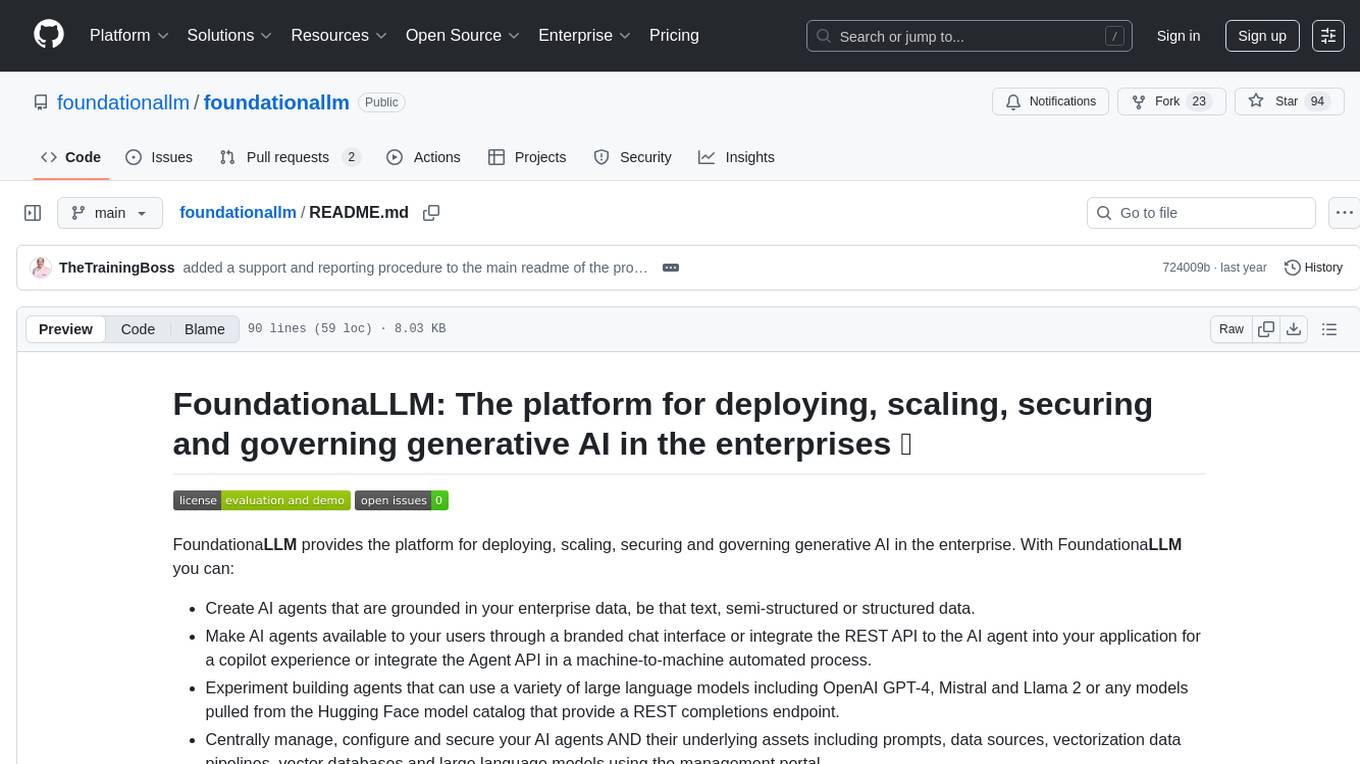
foundationallm
FoundationaLLM is a platform designed for deploying, scaling, securing, and governing generative AI in enterprises. It allows users to create AI agents grounded in enterprise data, integrate REST APIs, experiment with various large language models, centrally manage AI agents and their assets, deploy scalable vectorization data pipelines, enable non-developer users to create their own AI agents, control access with role-based access controls, and harness capabilities from Azure AI and Azure OpenAI. The platform simplifies integration with enterprise data sources, provides fine-grain security controls, scalability, extensibility, and addresses the challenges of delivering enterprise copilots or AI agents.
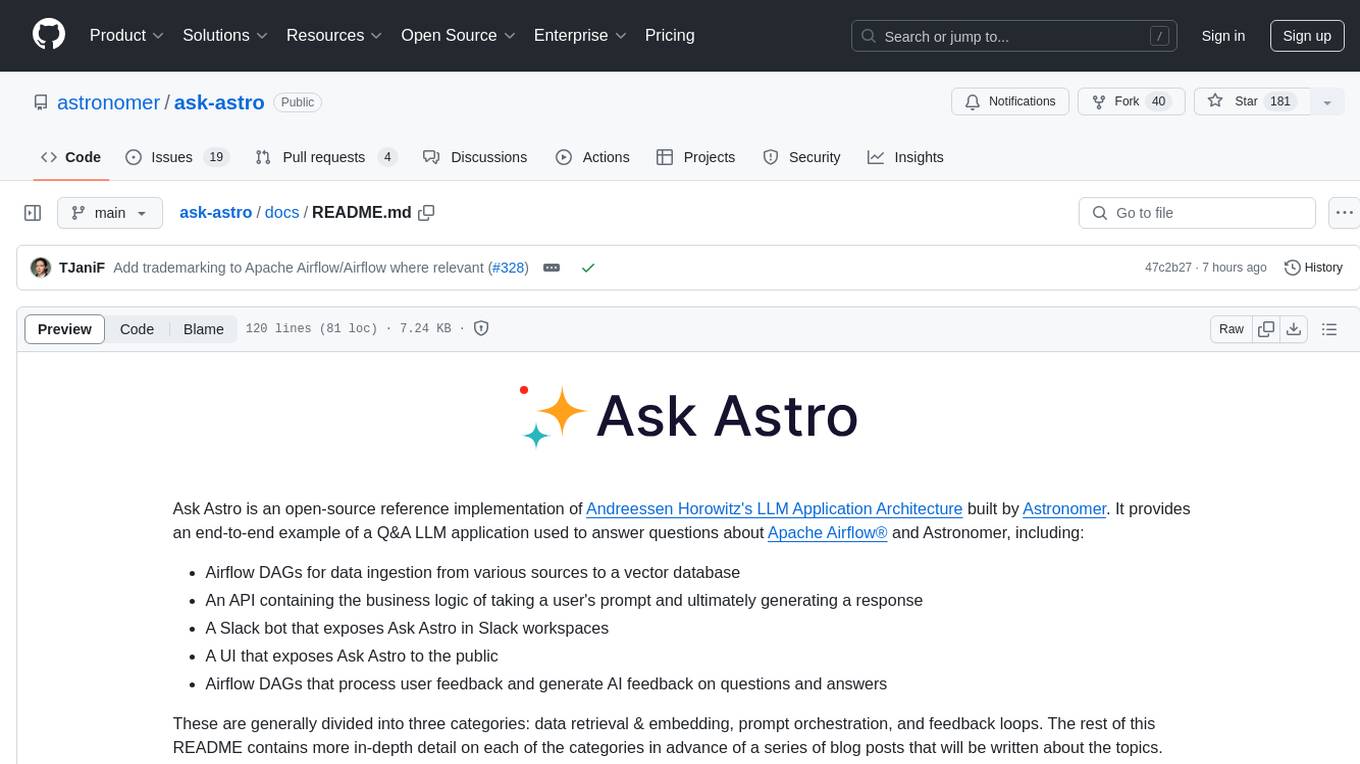
ask-astro
Ask Astro is an open-source reference implementation of Andreessen Horowitz's LLM Application Architecture built by Astronomer. It provides an end-to-end example of a Q&A LLM application used to answer questions about Apache Airflow® and Astronomer. Ask Astro includes Airflow DAGs for data ingestion, an API for business logic, a Slack bot, a public UI, and DAGs for processing user feedback. The tool is divided into data retrieval & embedding, prompt orchestration, and feedback loops.
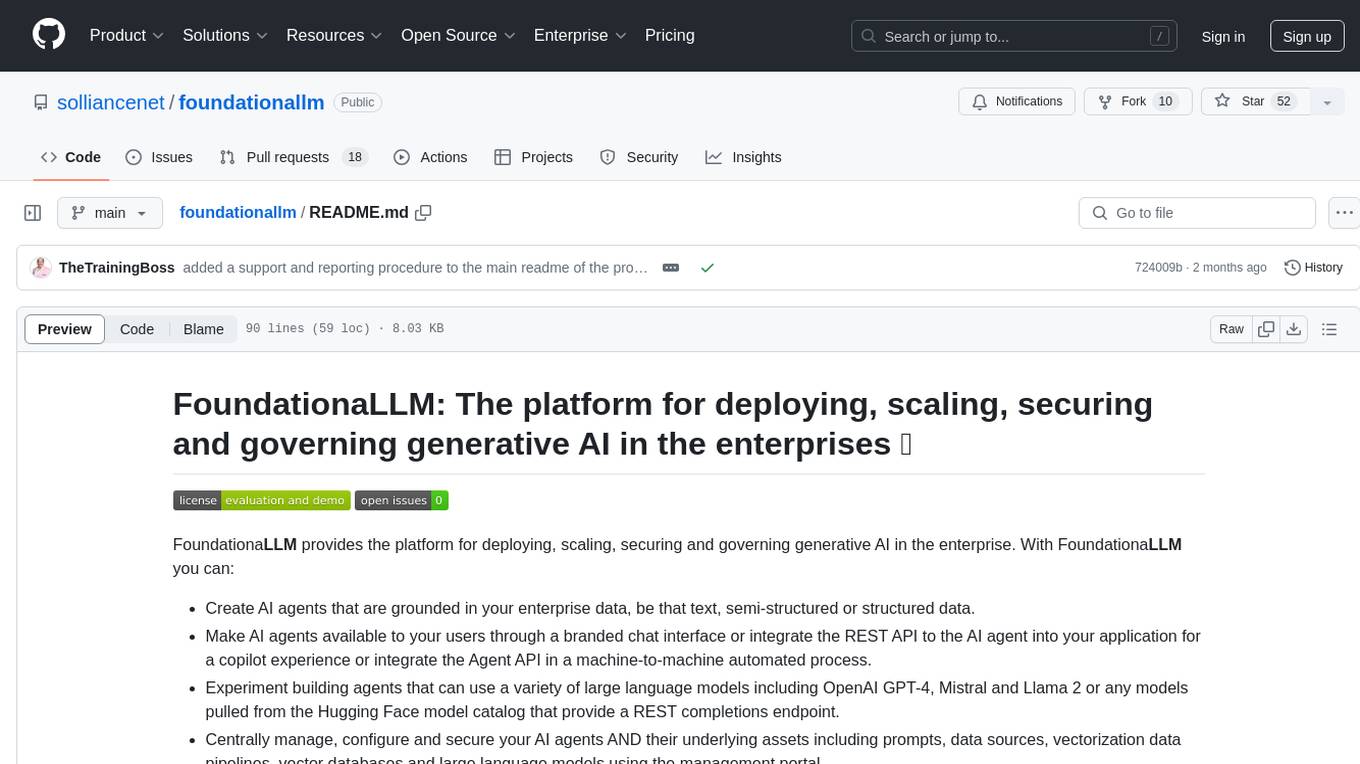
foundationallm
FoundationaLLM is a platform designed for deploying, scaling, securing, and governing generative AI in enterprises. It allows users to create AI agents grounded in enterprise data, integrate REST APIs, experiment with large language models, centrally manage AI agents and assets, deploy scalable vectorization data pipelines, enable non-developer users to create their own AI agents, control access with role-based access controls, and harness capabilities from Azure AI and Azure OpenAI. The platform simplifies integration with enterprise data sources, provides fine-grain security controls, load balances across multiple endpoints, and is extensible to new data sources and orchestrators. FoundationaLLM addresses the need for customized copilots or AI agents that are secure, licensed, flexible, and suitable for enterprise-scale production.
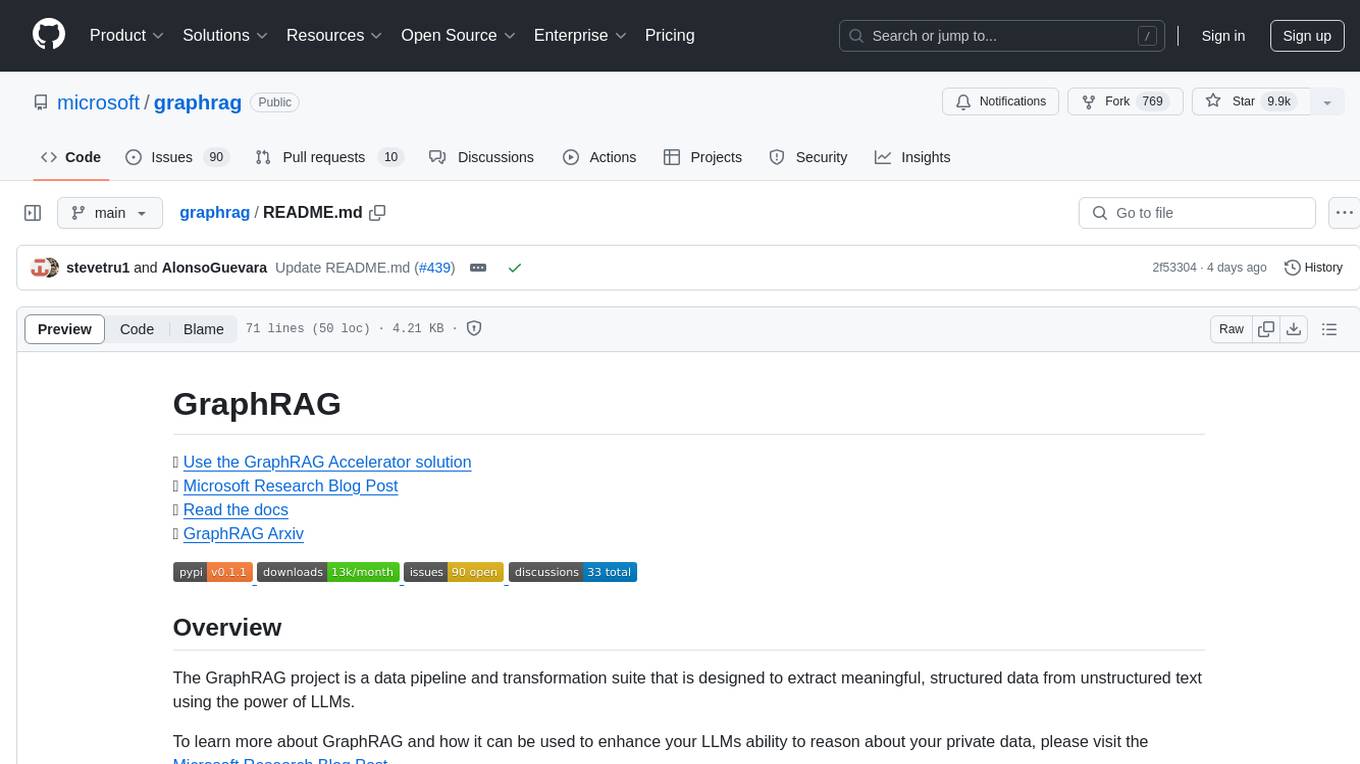
graphrag
The GraphRAG project is a data pipeline and transformation suite designed to extract meaningful, structured data from unstructured text using LLMs. It enhances LLMs' ability to reason about private data. The repository provides guidance on using knowledge graph memory structures to enhance LLM outputs, with a warning about the potential costs of GraphRAG indexing. It offers contribution guidelines, development resources, and encourages prompt tuning for optimal results. The Responsible AI FAQ addresses GraphRAG's capabilities, intended uses, evaluation metrics, limitations, and operational factors for effective and responsible use.
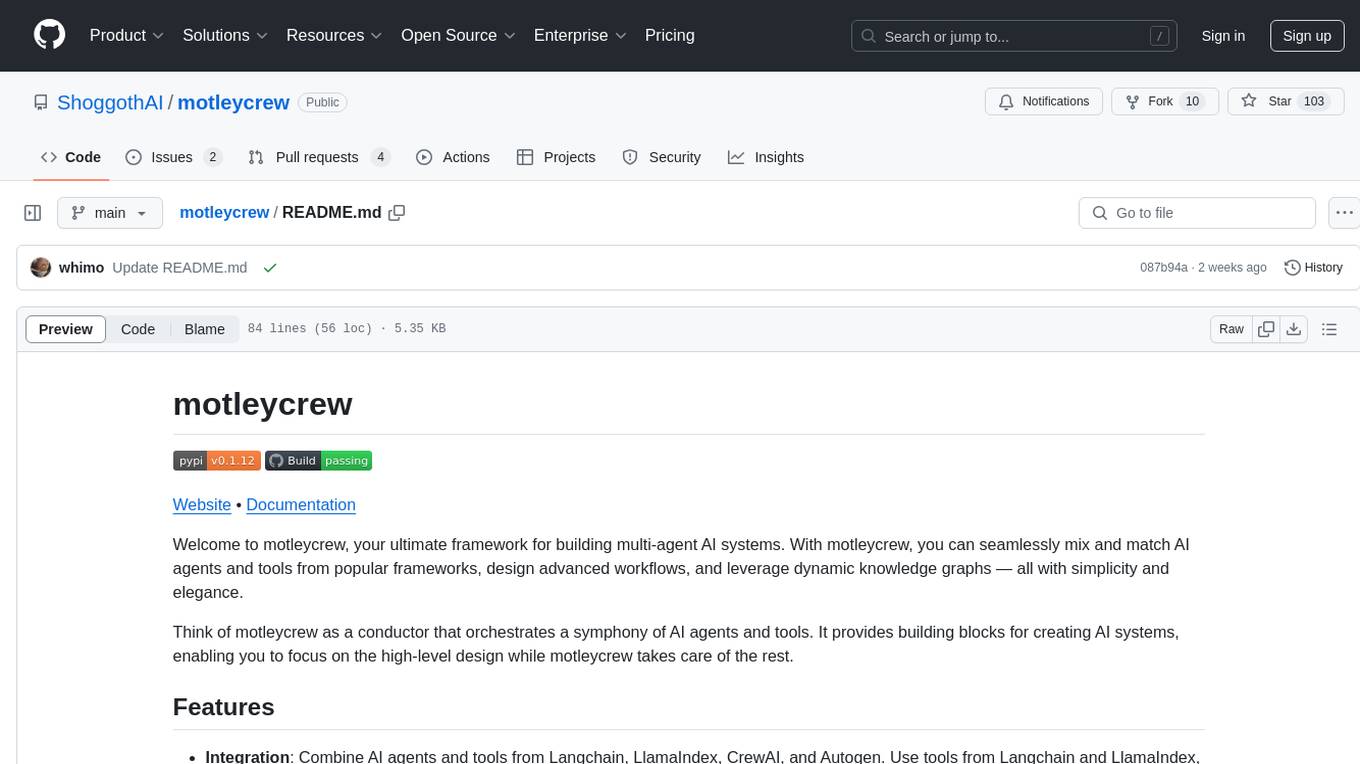
motleycrew
Motleycrew is an ultimate framework for building multi-agent AI systems, allowing users to mix and match AI agents and tools from popular frameworks, design advanced workflows, and leverage dynamic knowledge graphs with simplicity and elegance. It acts as a conductor orchestrating a symphony of AI agents and tools, providing building blocks for creating AI systems and enabling users to focus on high-level design while taking care of the rest. The framework offers integration with various tools, flexibility in providing agents with tools or other agents, advanced flow design capabilities, and built-in observability and caching features.
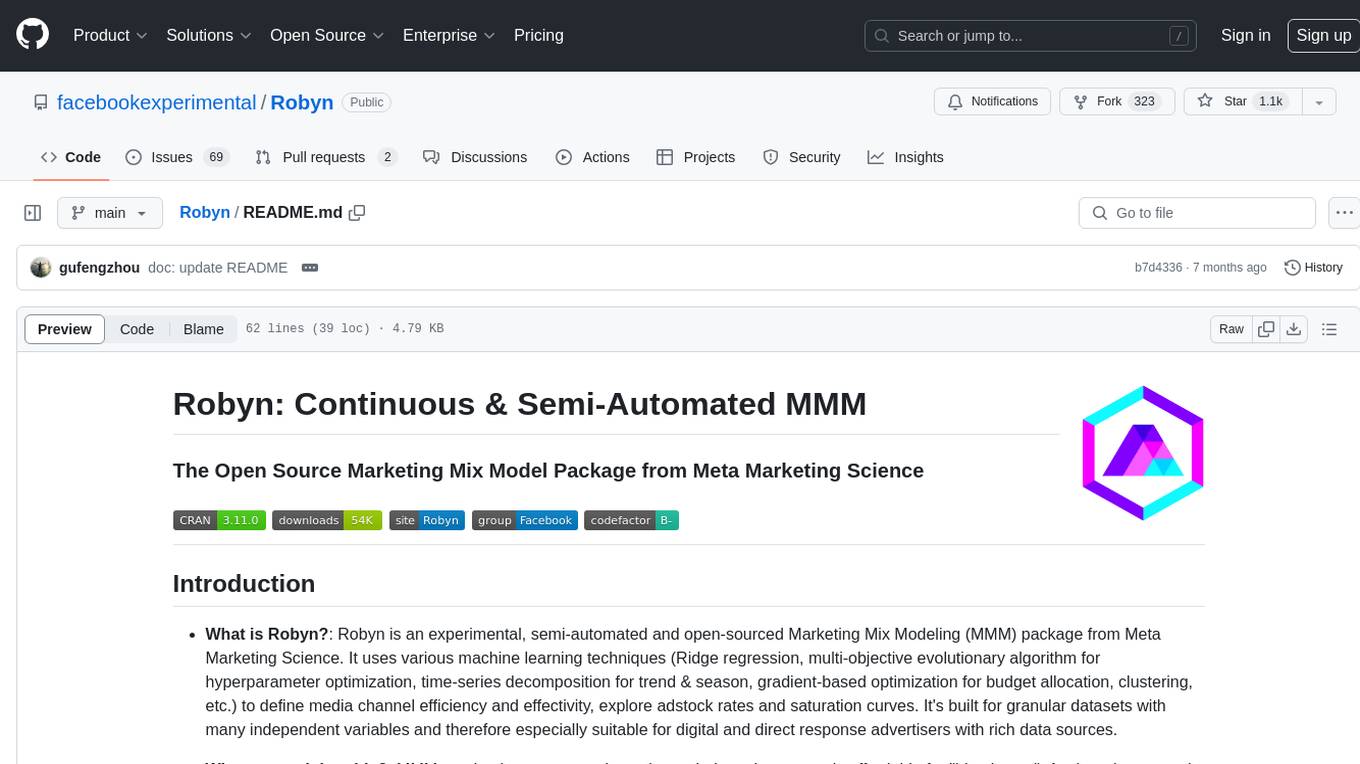
Robyn
Robyn is an experimental, semi-automated and open-sourced Marketing Mix Modeling (MMM) package from Meta Marketing Science. It uses various machine learning techniques to define media channel efficiency and effectivity, explore adstock rates and saturation curves. Built for granular datasets with many independent variables, especially suitable for digital and direct response advertisers with rich data sources. Aiming to democratize MMM, make it accessible for advertisers of all sizes, and contribute to the measurement landscape.
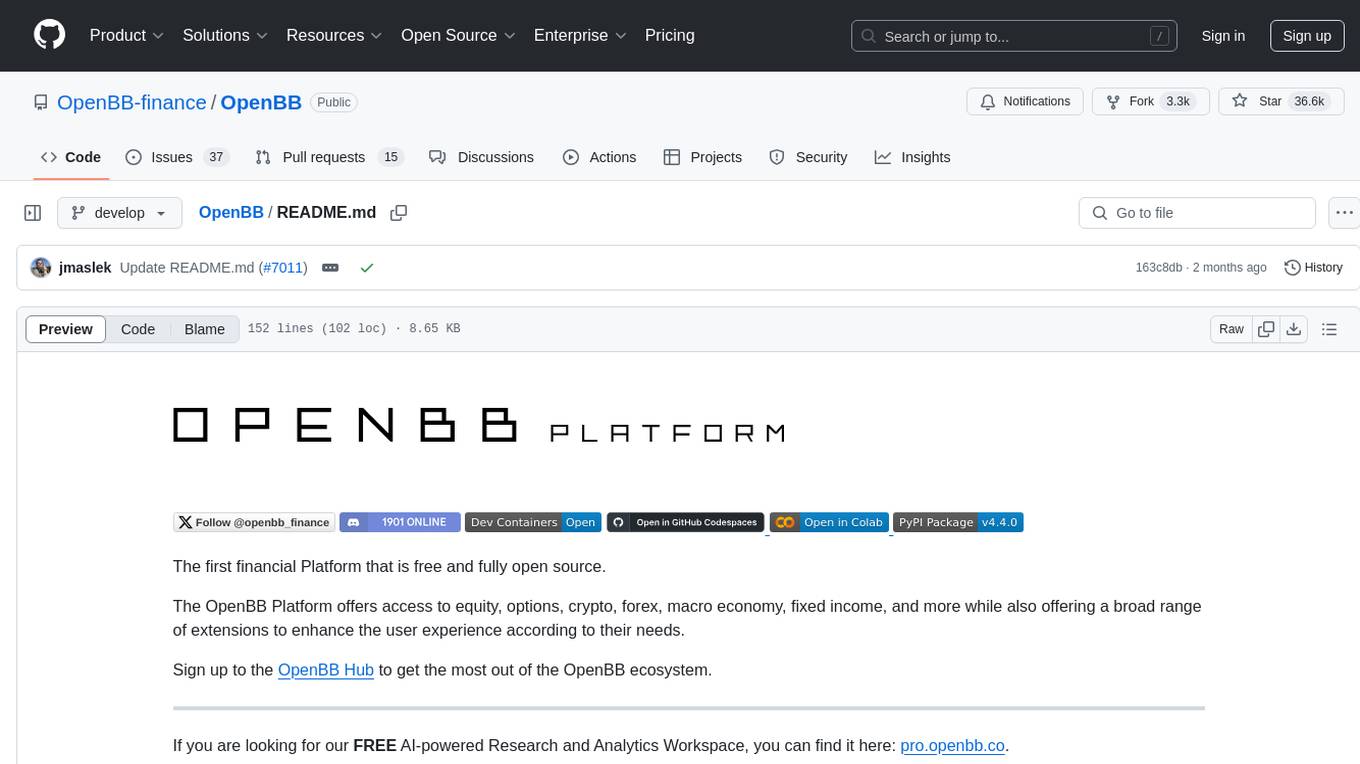
OpenBB
The OpenBB Platform is the first financial platform that is free and fully open source, offering access to equity, options, crypto, forex, macro economy, fixed income, and more. It provides a broad range of extensions to enhance the user experience according to their needs. Users can sign up to the OpenBB Hub to maximize the benefits of the OpenBB ecosystem. Additionally, the platform includes an AI-powered Research and Analytics Workspace for free. There is also an open source AI financial analyst agent available that can access all the data within OpenBB.
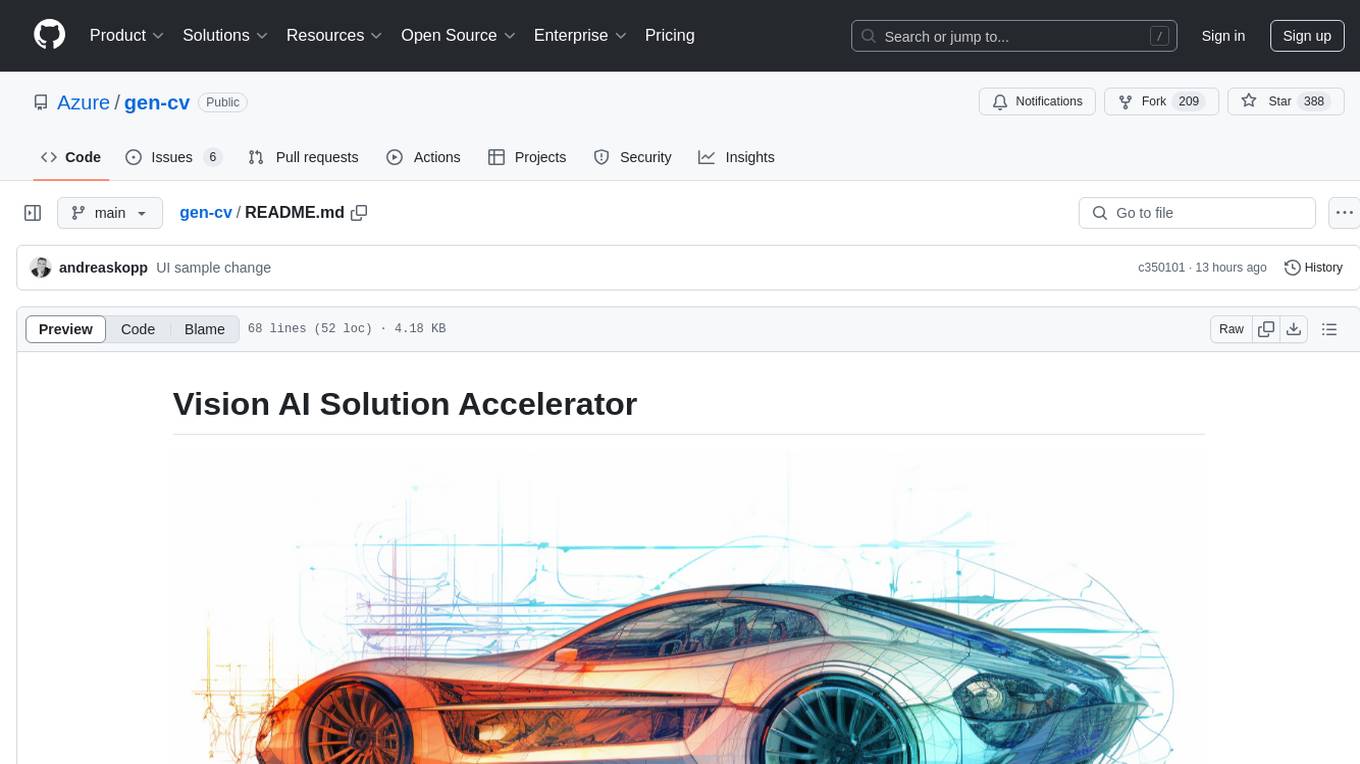
gen-cv
This repository is a rich resource offering examples of synthetic image generation, manipulation, and reasoning using Azure Machine Learning, Computer Vision, OpenAI, and open-source frameworks like Stable Diffusion. It provides practical insights into image processing applications, including content generation, video analysis, avatar creation, and image manipulation with various tools and APIs.
For similar tasks

HybridAGI
HybridAGI is the first Programmable LLM-based Autonomous Agent that lets you program its behavior using a **graph-based prompt programming** approach. This state-of-the-art feature allows the AGI to efficiently use any tool while controlling the long-term behavior of the agent. Become the _first Prompt Programmers in history_ ; be a part of the AI revolution one node at a time! **Disclaimer: We are currently in the process of upgrading the codebase to integrate DSPy**
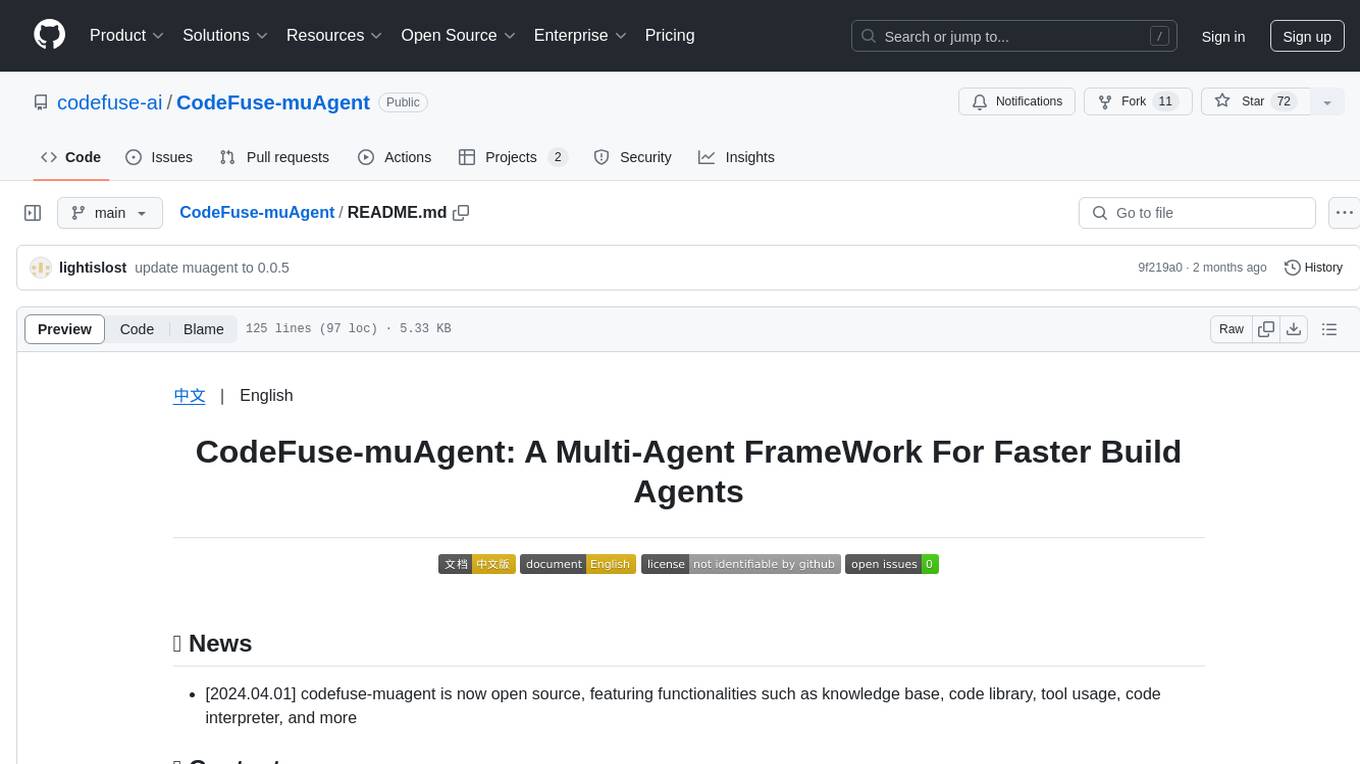
CodeFuse-muAgent
CodeFuse-muAgent is a Multi-Agent framework designed to streamline Standard Operating Procedure (SOP) orchestration for agents. It integrates toolkits, code libraries, knowledge bases, and sandbox environments for rapid construction of complex Multi-Agent interactive applications. The framework enables efficient execution and handling of multi-layered and multi-dimensional tasks.
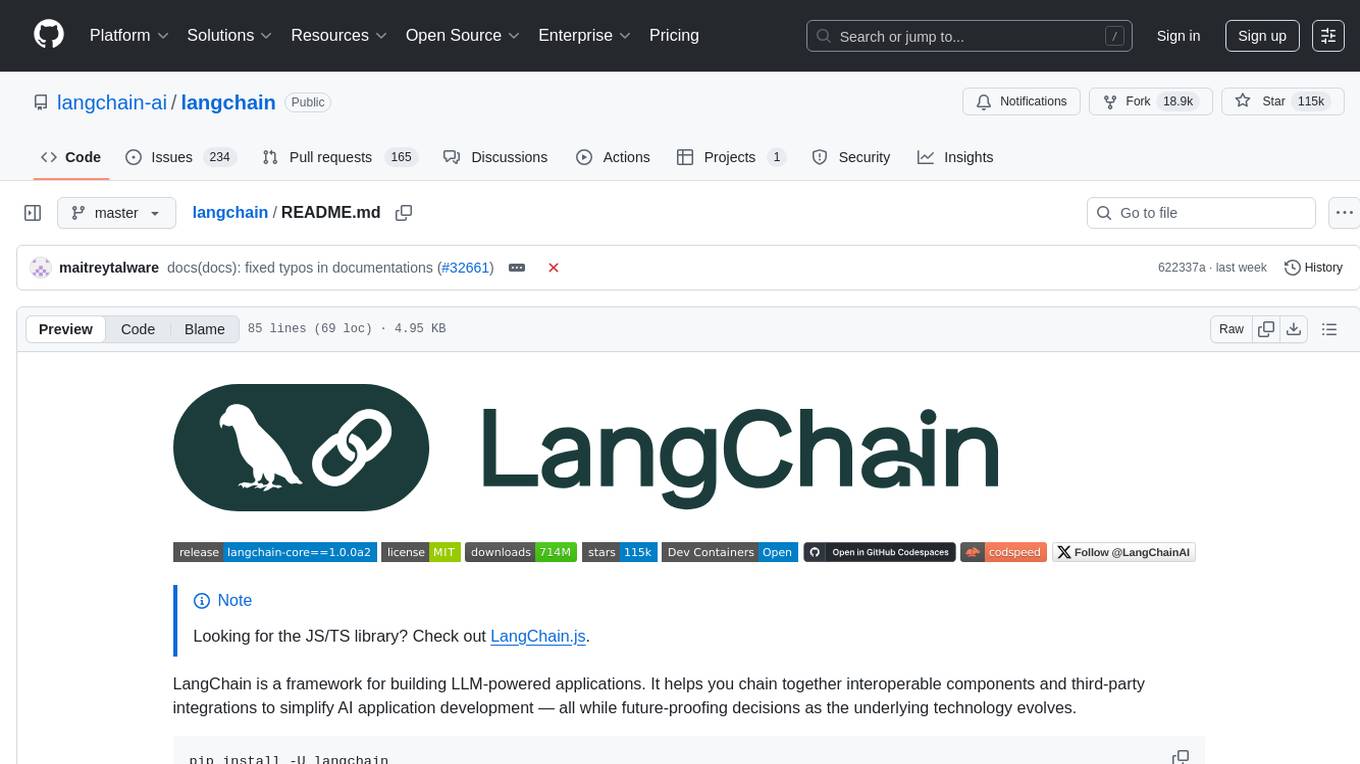
langchain
LangChain is a framework for building LLM-powered applications that simplifies AI application development by chaining together interoperable components and third-party integrations. It helps developers connect LLMs to diverse data sources, swap models easily, and future-proof decisions as technology evolves. LangChain's ecosystem includes tools like LangSmith for agent evals, LangGraph for complex task handling, and LangGraph Platform for deployment and scaling. Additional resources include tutorials, how-to guides, conceptual guides, a forum, API reference, and chat support.
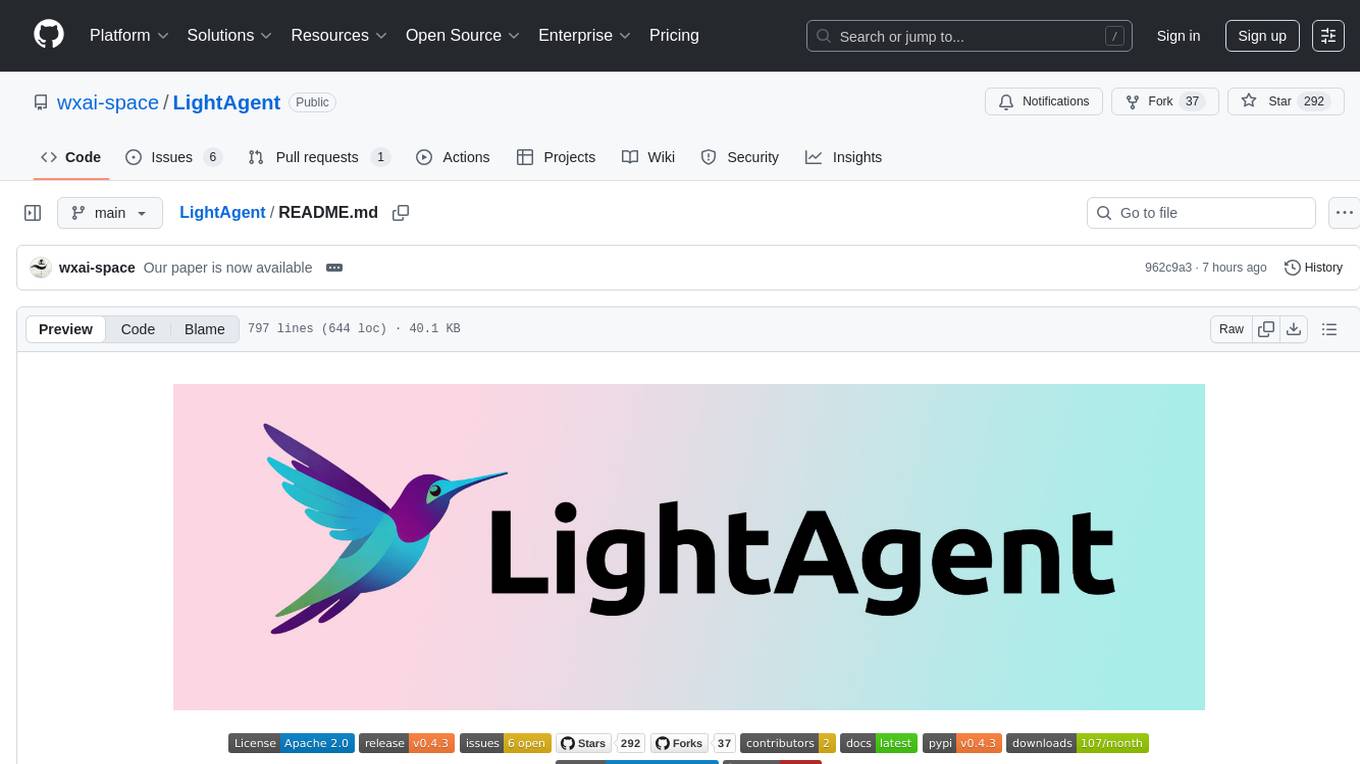
LightAgent
LightAgent is a lightweight, open-source Agentic AI development framework with memory, tools, and a tree of thought. It supports multi-agent collaboration, autonomous learning, tool integration, complex task handling, and multi-model support. It also features a streaming API, tool generator, agent self-learning, adaptive tool mechanism, and more. LightAgent is designed for intelligent customer service, data analysis, automated tools, and educational assistance.
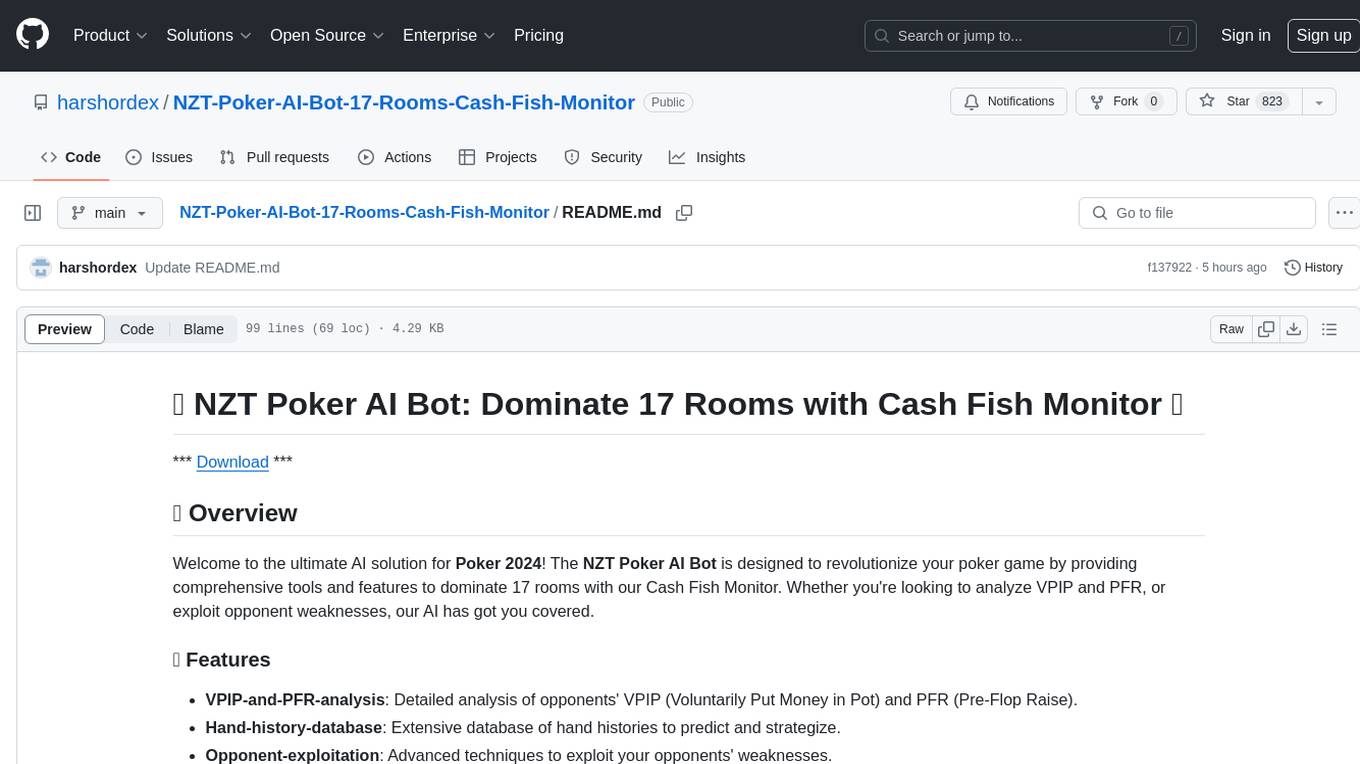
NZT-Poker-AI-Bot-17-Rooms-Cash-Fish-Monitor
The NZT Poker AI Bot is an advanced tool designed to revolutionize poker gameplay by providing comprehensive features to dominate 17 rooms with the Cash Fish Monitor. It offers detailed analysis of opponents' VPIP and PFR, extensive hand history database, opponent exploitation techniques, data-driven intelligence, player profiles, advanced neural network technology, expert training, continuous refinement, and cutting-edge algorithms for maximizing poker profits. Created by a team of poker experts, this AI tool continuously adapts to the latest poker strategies and utilizes state-of-the-art technology to enhance decision-making prowess.
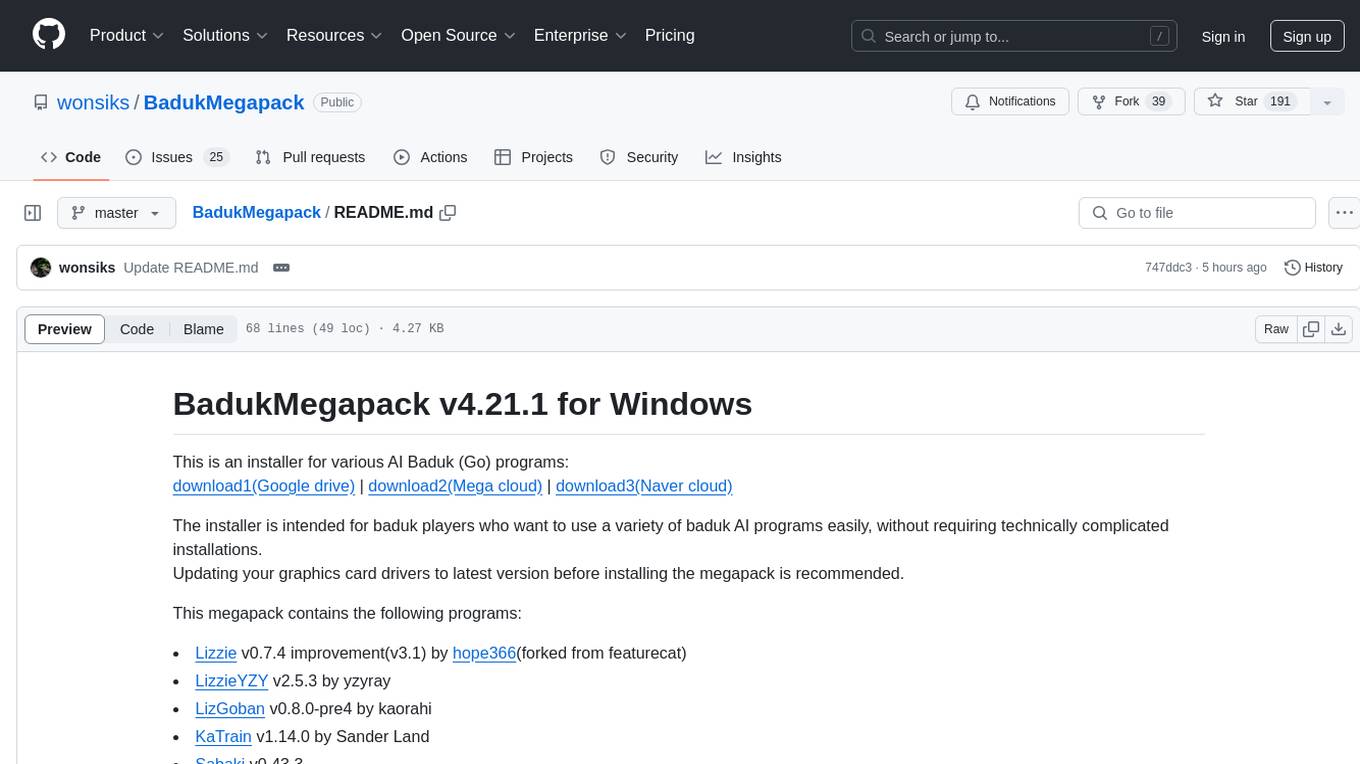
BadukMegapack
BadukMegapack is an installer for various AI Baduk (Go) programs, designed for baduk players who want to easily access and use a variety of baduk AI programs without complex installations. The megapack includes popular programs like Lizzie, KaTrain, Sabaki, KataGo, LeelaZero, and more, along with weight files for different AI models. Users can update their graphics card drivers before installation for optimal performance.
For similar jobs

HybridAGI
HybridAGI is the first Programmable LLM-based Autonomous Agent that lets you program its behavior using a **graph-based prompt programming** approach. This state-of-the-art feature allows the AGI to efficiently use any tool while controlling the long-term behavior of the agent. Become the _first Prompt Programmers in history_ ; be a part of the AI revolution one node at a time! **Disclaimer: We are currently in the process of upgrading the codebase to integrate DSPy**

weave
Weave is a toolkit for developing Generative AI applications, built by Weights & Biases. With Weave, you can log and debug language model inputs, outputs, and traces; build rigorous, apples-to-apples evaluations for language model use cases; and organize all the information generated across the LLM workflow, from experimentation to evaluations to production. Weave aims to bring rigor, best-practices, and composability to the inherently experimental process of developing Generative AI software, without introducing cognitive overhead.

agentcloud
AgentCloud is an open-source platform that enables companies to build and deploy private LLM chat apps, empowering teams to securely interact with their data. It comprises three main components: Agent Backend, Webapp, and Vector Proxy. To run this project locally, clone the repository, install Docker, and start the services. The project is licensed under the GNU Affero General Public License, version 3 only. Contributions and feedback are welcome from the community.

oss-fuzz-gen
This framework generates fuzz targets for real-world `C`/`C++` projects with various Large Language Models (LLM) and benchmarks them via the `OSS-Fuzz` platform. It manages to successfully leverage LLMs to generate valid fuzz targets (which generate non-zero coverage increase) for 160 C/C++ projects. The maximum line coverage increase is 29% from the existing human-written targets.

LLMStack
LLMStack is a no-code platform for building generative AI agents, workflows, and chatbots. It allows users to connect their own data, internal tools, and GPT-powered models without any coding experience. LLMStack can be deployed to the cloud or on-premise and can be accessed via HTTP API or triggered from Slack or Discord.

VisionCraft
The VisionCraft API is a free API for using over 100 different AI models. From images to sound.

kaito
Kaito is an operator that automates the AI/ML inference model deployment in a Kubernetes cluster. It manages large model files using container images, avoids tuning deployment parameters to fit GPU hardware by providing preset configurations, auto-provisions GPU nodes based on model requirements, and hosts large model images in the public Microsoft Container Registry (MCR) if the license allows. Using Kaito, the workflow of onboarding large AI inference models in Kubernetes is largely simplified.

PyRIT
PyRIT is an open access automation framework designed to empower security professionals and ML engineers to red team foundation models and their applications. It automates AI Red Teaming tasks to allow operators to focus on more complicated and time-consuming tasks and can also identify security harms such as misuse (e.g., malware generation, jailbreaking), and privacy harms (e.g., identity theft). The goal is to allow researchers to have a baseline of how well their model and entire inference pipeline is doing against different harm categories and to be able to compare that baseline to future iterations of their model. This allows them to have empirical data on how well their model is doing today, and detect any degradation of performance based on future improvements.






